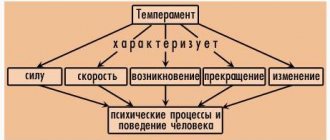When preparing a text, the author is faced with special types of speech - functional and semantic. This or that functional-semantic type of speech, subject to ethos and pathos, becomes part of logos.
Functional-semantic types of speech are types of monologue speech that are characterized by their own goals and objectives, uniformity of content, composition and speech features. The following types of speech are distinguished: description, narration, reasoning
Sociability as a person’s personal qualities
It is important to choose the right channel. For the exchange of information to be effective, the channel must correspond to the idea originated in the first stage, be compatible with the type of symbols used for encoding.
Examples of poor channel manager choices:
a) The manager wants to point out to the subordinate his poor work, mistakes, violations, and does this during a light conversation over a cup of coffee or sends him a note. It is clear that through these channels it will not be possible to convey the idea of the seriousness of the subordinate’s violations. Here you should choose channels such as a formal letter or a meeting.
b) The manager wants to recognize the special achievements of a subordinate and sends him a memo. In this case, other effective channels will be: a conversation with a subordinate, and then a formal letter expressing gratitude.
Recipient
- the person to whom the information is intended.
Communication occurs for the sake of the recipient. The recipient decodes the message. Decoding
is the translation of the sender's symbols into the recipient's thoughts. If the characters chosen by the sender have exactly the same meaning to the recipient, then he will know exactly what the sender meant.
If the recipient has demonstrated understanding of the idea by performing the actions expected by the sender, the exchange of information is effective. These actions are feedback.
Feedback -
the recipient's reaction to the message. It makes communication a dynamic two-way process. The more actively feedback is used in the communication process, the more effective it is.
Positive feedback informs the source that the desired outcome of the message has been achieved. Negative feedback informs the source that the desired outcome of the message was not achieved.
Ten Commandments of Successful Communication:
- Before communication, clearly define the ideas put into the message.
- Analyze the true purpose of each communication.
- Analyze the entire physical and human environment of any communication.
- Consult with others when planning communications.
- Pay close attention to the intonation and main content of the message.
- Take advantage of opportunities when they present themselves to include something useful and valuable to the recipient or recipient of the message.
- Keep an eye on how communication is working at all times.
- Establish communication not only for today, but also for tomorrow.
- Make sure that the actions of the installation do not contradict the words.
- Learn the ability to listen to others.
Thus, communication performs many functions and includes a large number of elements. Therefore, we can say that without communication, any type of activity is practically impossible.
1.2. The role and significance of speech communication in the professional activities of people
The professionalism of a specialist in the field of socio-cultural services and tourism consists of many components. He must have regional studies, cultural studies, economics, sociological and psychological knowledge. But regardless of what exactly his professional activity is - developing new routes, marketing research, selling vouchers and tickets, conducting excursions, etc. - he has to constantly communicate with colleagues, partners and clients. Language proficiency is one of the most important components of professional skill for a tourism specialist, determining not only the success of business contacts, but also his internal rating in a travel company.
In accordance with the main functions of the profession, a specialist in the field of tourism must be professionally trained; erudite in the field of culture, politics, economic and social development of society; be able to foresee the consequences of your actions; have professional tact, conscientiously fulfill your professional duty, without losing goodwill and attention to the client; be able to clearly formulate and correctly express your thoughts, and most importantly, have communication skills;
Communication in professional activities, including tourism, performs the following functions:
- informative;
- integrative, manifested in the transformation of the specialist’s personality into a member of the socio-cultural society;
- differentiating, emphasizing the bright individuality of a specialist in the process of communicative relationships with colleagues and clients;
- core meaning, which allows a specialist to find himself, build a hierarchy of life and professional values2;
- social, as it helps the specialist organize mutual understanding and relationships with clients using various communication means.
The formation of professionally significant competencies in the field of speech communication by a specialist in the field of socio-cultural services and tourism is a complex and multifaceted process. First of all, it is associated with the enrichment of a person’s general culture, the development of his spiritual and moral qualities, and a humane attitude towards others. All subsequent knowledge acquired by students in accordance with the chosen specialization will simultaneously serve as the goal and means of developing his communicative, social and psychological skills, which he will need in the process of communicating with representatives of different cultures and professional groups.
Thus, the role of speech communication in management activities is very great. The formation of communication networks and the creation of conditions for the successful functioning of communications in an organization constitute one of the most important management tasks. It is no coincidence that the German scientists W. Siegert and L. Lang o.
Thus, verbal communication as a reflection of the level of culture and education of a specialist in such a communication-oriented industry as tourism is the key to the success of his professional activity, a factor of self-realization and self-identification in society, the goal of constant self-development and improvement.
Section 2. Communication skills as a personal quality of a person
2.1. Communication abilities and aptitudes of a person
"The greatest luxury in the world is
this is the luxury of human communication"
Antoine de Saint-Exupery
Today, as a rule, most applicants for decent vacancies - managerial and well-paid positions - are invariably presented with such a requirement as communication skills. What is communication skills?
Communication skills
(from Late Latin communicabilis - connectable, communicating) - 1) compatibility (ability to work together) of different types of information transmission systems; 2) ability to communicate, sociability.3
Sociability can be understood as the ability to establish connections between people (friendly, business) and between different types of information transfer systems.
In the psychology of communication, sociability is the ability to establish contacts, the ability to have constructive and mutually enriching communication with other people. Communication is one of the defining skills of successful social interaction, affecting both professional and personal relationships. It is one of the most important personal qualities in professions that involve active communication with other people.
The communication skills of a tourism manager are among his most important professional qualities, which predetermines their identification at the stage of university education. The domestic theory of abilities was created by the works of many prominent psychologists, including B. G. Ananyev, S. L. Rubenstein, B. M. Teplov and others. Abilities are the ability to achieve a high level of mastery in a particular activity. There are general and special abilities. General abilities are necessary for a wide range of knowledge. General abilities include qualities such as attentiveness, intelligence, determination, efficiency, etc. These qualities are important in all types of activities, including in the field of management. Special abilities are qualities that ensure success in a narrow range of activities. These, for example, include visual memory, understanding people, etc. Communication and organizational skills can also be classified as special abilities, but it is these abilities that play a big role in a person’s professional growth and establishing effective communications.
The ability to communicate is manifested in the level of implementation in an individual of all three aspects of communication:
w communicative – in the means of transmitting information (written and oral speech, gestures, facial expressions, etc.);
w interactive – in methods and techniques of psychological influence and active interaction in joint activities;
w perceptual – in interpersonal perception, assessment and mutual understanding of people.
The ability to communicate also presupposes a developed degree of socio-psychological adaptation, that is, the individual’s active adaptation to the conditions of a new social environment, the ability to exert a psychological influence on others, to convince them and win them over.
Social perception is manifested in the ability to perceive people, adequately evaluate, empathize and understand them. On this basis, effective interaction with people, exchange of information, behavior consistent with social norms are built, and organizational and communicative qualities of the individual are developed.
At all times, people have valued the ability to communicate with other people, the ability to find a common language in any situation, resolve controversial issues, etc. Not every person has this ability; for various reasons, we all have barriers that prevent us from conducting a monologue or dialogue with partners, co-workers, etc. Here are some examples of such barriers:
- fear of being misunderstood;
- lack of confidence in one's rightness;
- reluctance to participate in discussion (although this is necessary in a business environment);
- low self-esteem;
- reluctance to “shine”.
It is precisely such barriers that usually prevent a person from demonstrating his knowledge in any field among colleagues and in life. A person’s sociability helps him move up the career ladder and achieve success in interacting with people.
A sociable person is an extremely valuable phenomenon, he is capable of creating a huge number of useful connections, he is aware of events, and where there is new and reliable information, there is success. Communication skills imply two-way interaction, i.e. a person must not only speak well, but also be able to listen, hear and understand what the respondent wants to convey. There are plenty of people who can speak at length and volubly, but there are only a few who are able to adequately hear their interlocutor.
Effective listening and speaking skills, being opposite but interconnected aspects of the same process, are the most important means of communication. In most cases, interlocutors are valued not for their ability to speak, but for their ability to listen carefully and kindly. If a tour operator wants clients to be able to overcome constraint, shyness, fear of being misunderstood, to fully speak out on an issue that interests them, accurately state their preferences, and most importantly, to gain satisfaction from communicating with a travel agency specialist and leave the office in full confidence that the people working there are competent, Well-mannered, responsible employees, he must learn to restrain his emotions, not interrupt his interlocutors, and help them with so-called “opening” remarks and “leading” questions.
Why is functional diagnostics needed?
Our jaw system works in a certain balance. And if we lose one, several or, especially, all teeth, then the chewing load ceases to be distributed correctly. A misalignment of the bite inevitably affects the condition of the facial muscles, ligaments and joints - overloads occur in the most common movements.
In order to solve these problems, it is not necessary to go to a neurologist, osteopath or plastic surgeon, take expensive massage courses, or inject untested and even dangerous medications. It’s enough to just take care of your teeth – restore them, but it’s very important to design the denture correctly. So that it does not cause discomfort when chewing. And for this, the orthopedic dentist needs to collect as much information as possible about the operation of the patient’s jaw apparatus. This can be done by conducting a full functional diagnosis before prosthetics. That is, get not only static, but also dynamic data.
If the prosthesis is created in accordance with your appearance and bite, then it is not only aesthetic, but also comfortable and functional. You may even forget that you have false teeth, they feel so natural. Photo: Smile-at-Once
How is functional diagnostics carried out?
You can't watch the jaw system work live. The doctor’s human gaze will not “catch” how your jaw moves at the microscopic level, and will not be able to assess the difference in movements while eating and talking. Meanwhile, all this affects the functioning of the jaw system - if you correctly restore bite relationships and articulation, identifying all pathologies, you can get rid of many problems. Simply by creating the right prosthesis.
The virtual model, on the basis of which the prosthesis is developed, is created according to the patient’s bite parameters. To remove them, dentists use a number of diagnostic devices - computed tomography, face bows, jaw position analyzers, devices for graphically recording the articular path, articulators, etc.
“In addition to traditional methods, we use an innovative set of devices for digital diagnostics and analysis - an optical axiograph, intraoral and facial scanners, and digital face arcs. They evaluate exactly the dynamics - how you chew, how you speak, how your jaw moves, how your muscles and joints function. There are no distortions in digital diagnostics - such preparation for treatment takes the comfort of future prostheses to a new level. The result becomes predictable. And in combination with the digital design of your smile using Digital Smile Design technology in compliance with the principles of the “golden ratio”, you get just the perfect result.
And we are the first clinic in the country to use digital diagnostics on such a large scale before any prosthetics, especially with complex implantation with immediate loading, when fixed dentures are placed already on the 3rd day after installation of the implants,” comments Andrey Rastislavovich Chernov, dentist -orthopedist Smile-at-Once.
Facial bow and optical axiograph for taking bite parameters and assessing chewing movements. Photo: Smile-at-Once.ru
What are the advantages of this approach?
The best reward for a doctor is not only the sincere smile of his patient, but also when a person forgets that he has artificial teeth. Simply because they look and feel natural. That is, they support the healthy functioning of the jaw system and do not interfere even in small things.
The most noticeable results are noted by those patients who have been missing teeth for a long time. As a rule, before treatment, they accumulate problems with the temporomandibular joints, pain, migraines, heaviness in the jaws, crunching and clicking when opening the mouth. And the best solution in such cases now is fixed prosthetics supported by implants. Such structures can become an almost complete analogue of real teeth, both in appearance and in terms of functionality. Of course, if their development is approached with the utmost care - complex diagnostics, digital technologies and 3D planning are involved.
Prostheses created on the basis of functional analysis are able to remove excess stress from the joints, gradually restore bite relationships and muscle balance. This means that pain when chewing will go away, and freedom in speech and facial expressions will appear. You can calmly eat your favorite foods, talk, laugh without fear or fear that your jaw will tighten or there will be acute pain.
This is how the patient changes after complex implantation with the installation of a prosthesis immediately. The smile is beautiful, the teeth are fully functional. Photo: Smile-at-Once
Some digital diagnostic devices can be found in different clinics. The cost, as a rule, varies from 20 to 50 thousand rubles. But comprehensive preparation for prosthetics is currently only carried out at Smile-at-Once. Here, in-depth digital diagnostics are immediately included in the cost of complex prosthetics on implants or on your own teeth; the patient does not have to pay for it separately. The clinic’s specialists are interested in understanding the patient’s problems in as much detail as possible and restoring a healthy smile. With a lifetime guarantee for implantation and free service.










